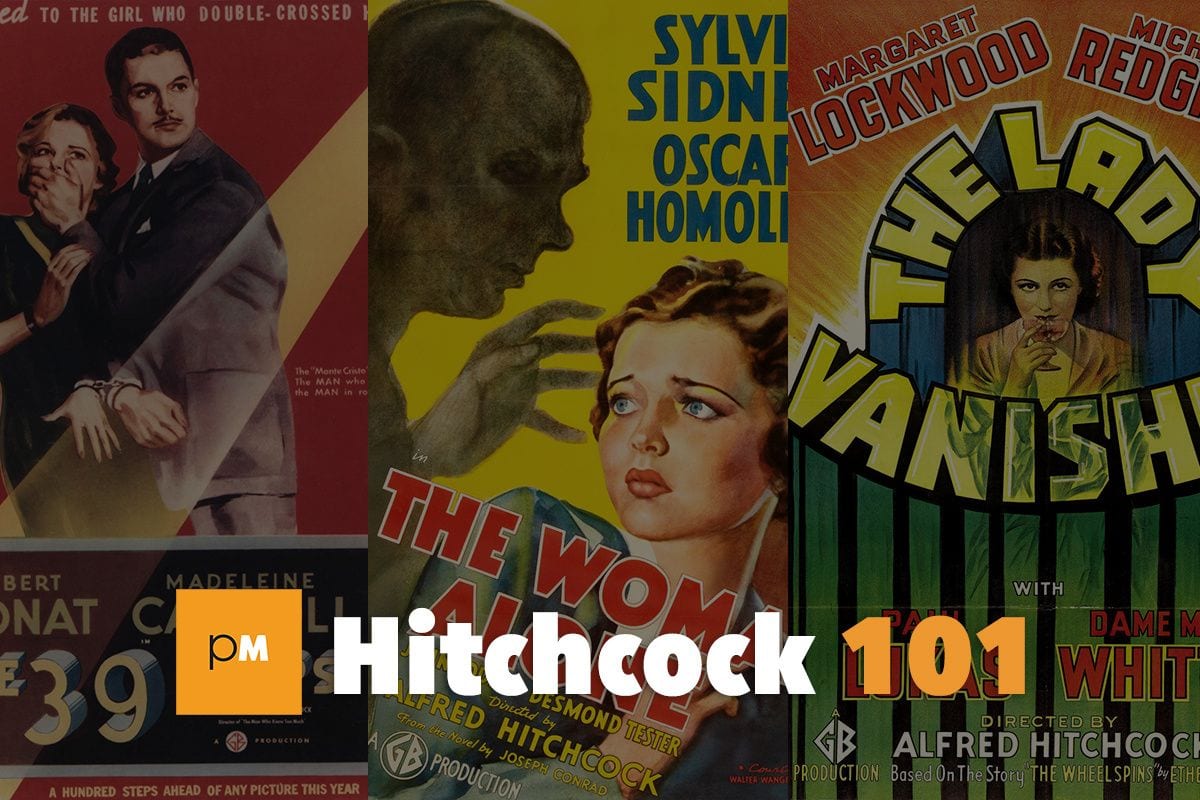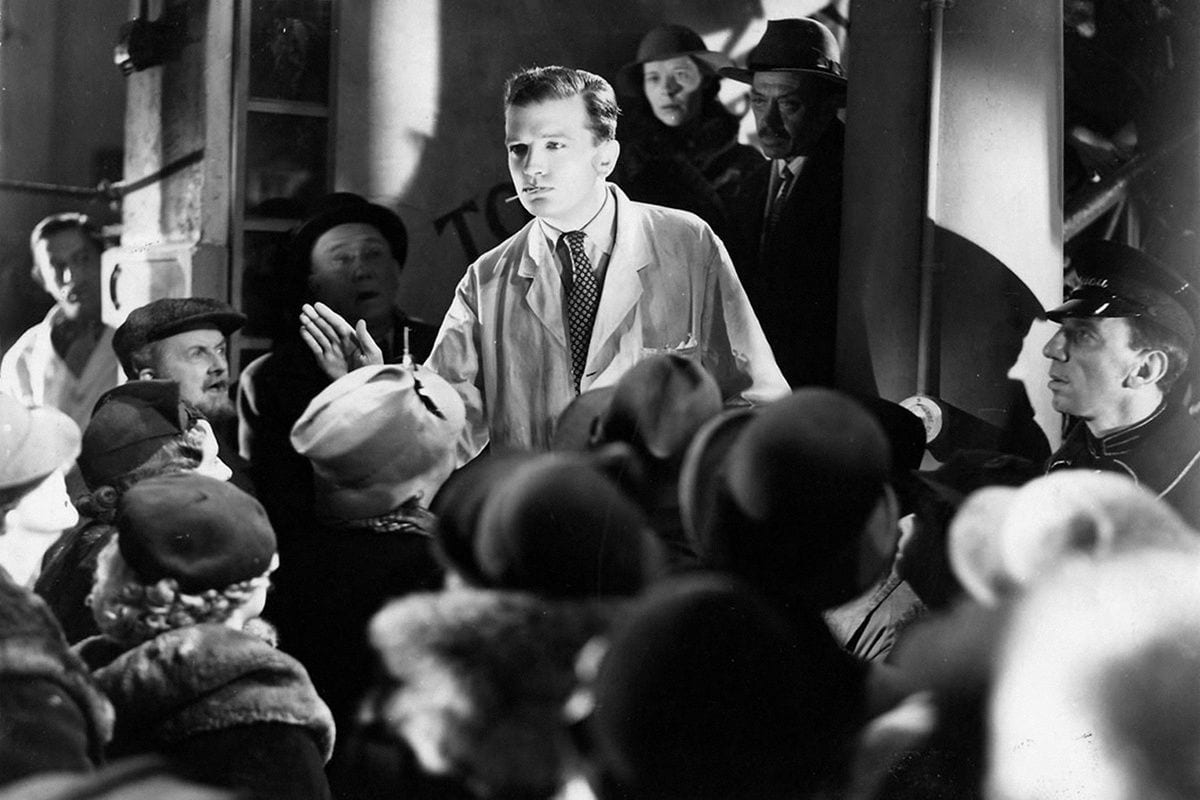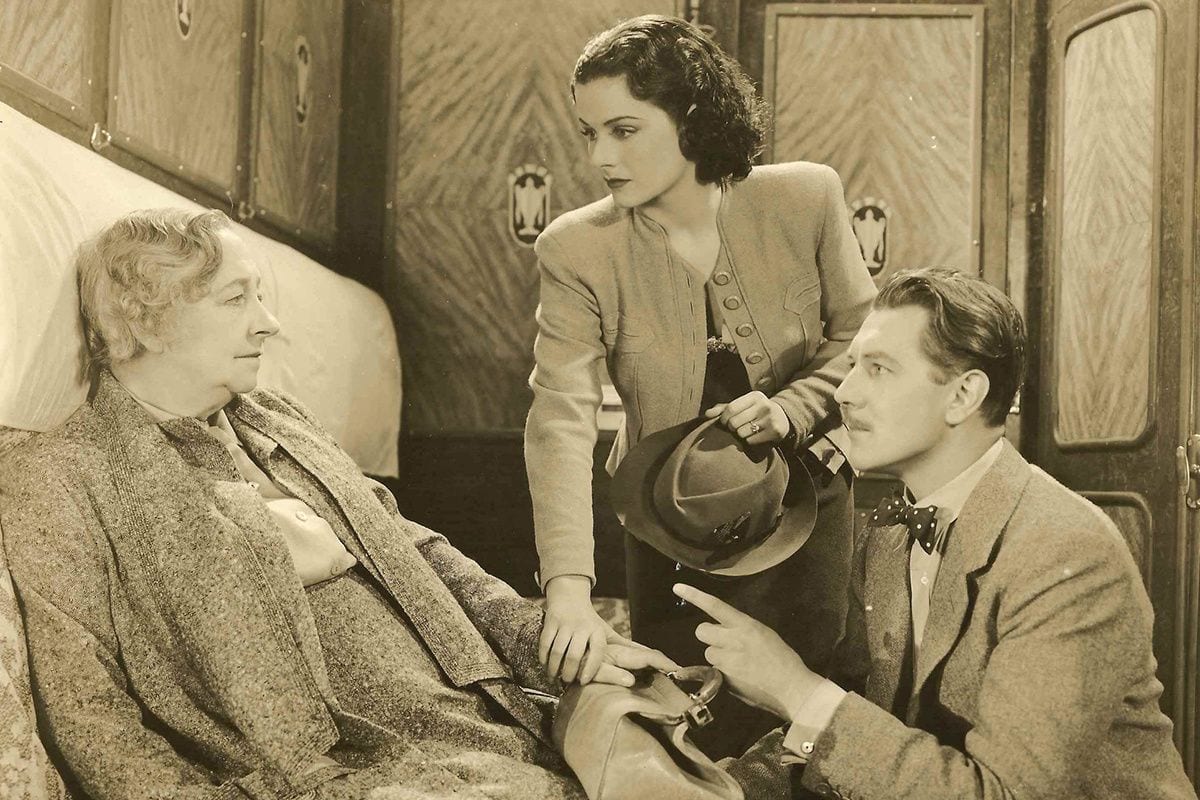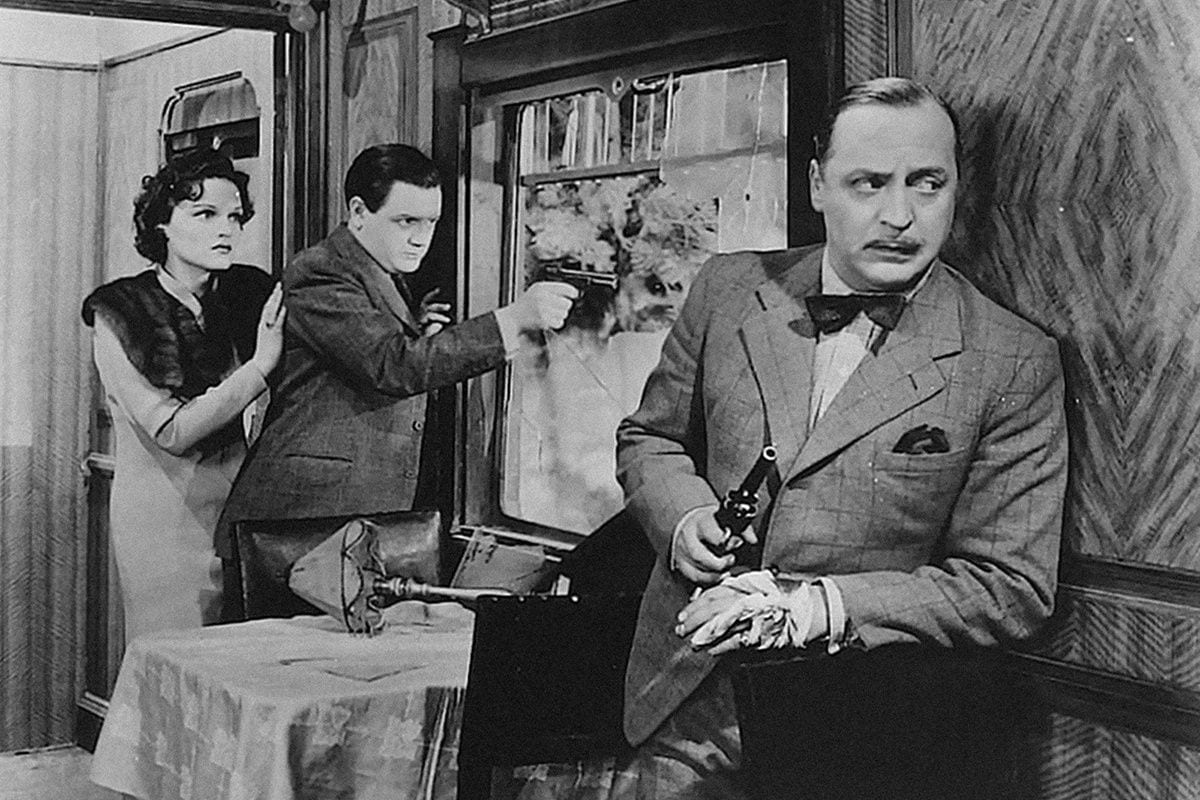The 39 Steps (1935)
Poster for The 39 Steps / The Alfred Hitchcock Wiki
Among Hitchcock’s most widely revered British-era films, The 39 Steps is both a tour de force in its own right and a template for his future masterpieces. Most of the celebrated Hitchcock trademarks are here, including the “wrong man” theme, the “MacGuffin”, a train journey, the odd mixture of murder and humour, and the gorgeous blonde who may or may not be trustworthy. The shot construction is elegant, the tension palpable, and the bad guys sinister. The only serious complaints that have been lodged against this mostly perfect thriller surround the apparent laziness on the part of all concerned with getting the actors to perform appropriate accents. (This only sort of bugs me, since accents are so often laughably bad in films from this era, but it is true that western Canadians will have trouble finding something of themselves in Robert Donat’s Richard Hannay.) That trifle aside, what we have here is an entertaining, romantic, funny, and tense escapade which, more successfully than any of his films up to that point, demonstrates Hitchcock’s incomparable genius.
The 39 Steps follows Hannay, a Canadian everyman, as he becomes embroiled in a hopelessly complex international political intrigue. We, the only people other than the villains who know the truth, wander with Hannay as he attempts the impossible: cracking the mystery and clearing his name. You may recognize this plot. About every third thriller since 1935 has used this same basic concept — since screenwriters understand that it’s a lot of fun to identify with a guy who might just be you but for the grace of the big guy — and Hitchcock himself essentially re-imagined The 39 Steps as North by Northwest 20 years later. But, where the latter film made use of bigger budgets and wild stunts and major landmarks, the earlier stab at the concept operates on a smaller, more intimate, and (as a result) more realistic scale. Yes, we can sort of identify with NxNW‘s Cary Grant for awhile, but eventually a guy will try to hit him with a plane. A plane. This is something that is hard to imagine might happen to you. But, being chased by police while handcuffed to a beautiful woman intent on turning you in? Well, it’s not entirely plausible, but at least it’s a bit less totally absurd. (Okay, the whole bullet vs. bible thing is preposterous, and the autogyro is unlikely. But at least it’s not a plane.)

It is, for me, its human scale that makes The 39 Steps so affecting. As Hitchcock told filmmaker and acolyte Francois Truffaut, “I made sure the content of every scene was very solid, so that each one would be a little film in itself.” Indeed, this is a film comprised of setpieces. To my mind, the most effective example of the merit of this construction is found in the lengthy sequence a third of the way into the film at the farmer’s croft. On-the-lam Hannay has stumbled onto this quiet place, and has tried to win a night’s stay out of the middle-aged man and his much younger wife. We sense that she has become bored and dissatisfied with her life on the farm, and that she misses the bustle of Glasgow; she looks to Hannay as a sophisticated diversion.
A little fire is kindled between the desperate-to-impress Hannay and the admiring young woman, a point not lost on the increasingly jealous farmer. Having discovered Hannay’s secret, she helps him to escape an approaching search party. But, while Hannay is now free to run some more, we are left with the awful knowledge that, aware of what she has done, the farmer will set about beating his wife. A little fun, a few jokes, a warm and friendly character, and then this bleak conclusion. It is a complete story, a dark note of tragic realism to cast a shadow on the fantasy of high adventure.
But for most viewers, The 39 Steps stands as a classic example of the mingling of romance and intrigue. In one of its most influential conceits, Hannay’s need to convince Pamela (Madeleine Carroll) of his innocence is paralleled by his romantic desire. Indeed, the conflation of the film’s two conclusions — sex and vindication — is established at their first meeting. Bursting into her train compartment and in need of a way to hide his identity, Hannay forces Pamela to kiss him so as to throw off his pursuers.
From this moment onward, Hannay must convince her to trust him, to believe in him, and to stop trying to turn him in to the cops at every opportunity, while always between them there is this thickening of the romance in the air. In order to save himself, he must first win her over. In order to sleep with her, he must do said same. The handcuffs which bind them for awhile are the obvious literal manifestation of this twinning of the drive toward sex and freedom, and never more so than when Pamela scandalously removes her stockings while attached to Hannay. Indeed, one way to watch The 39 Steps, from that first kiss (signifying escape) to their final scenes together, is as a carefully constructed riff on Edwardian courtship rituals. Masterful stuff.
(Fun fact: the man who wrote the book upon which the film was based — John Buchan — became Canada’s Governor General, which is the Queen’s representative in the country and technically the acting head of state, though in reality mostly a figurehead. I wonder what he thought of Donat’s accent?) — Stuart Henderson
Sabotage (1936)
Publicity still for Sabotage (1936) / The Alfred Hitchcock Wiki
Since Hitchcock had already made a (not very good) picture called Secret Agent earlier that year, it was decided that his film version of Joseph Conrad’s novel The Secret Agent would be titled Sabotage. This wouldn’t have been that confusing, but for Hitch’s unfortunate decision a few years later to make a film called Saboteur, thus forever confusing dimwits like me. I am continually prone to mixing up these three very different films; I was once halfway through a conversation (which conversation was becoming increasingly nonsensical for both parties involved) before it was determined that we were talking about totally different movies. Even more bewildering: Sabotage‘s alternate titles were, variously, “I Married a Murderer”, “The Woman Alone”, and “The Hidden Power”. Anyway, if you came here to read about Frank Frye et al. (or, for that matter, Ashenden and the General), you’re probably not alone. Sorry.
Like many thrillers of the era, Sabotage opens with a close-up on a dictionary definition which anticipates what’s to come. “Sabotage”, it explains, is the deliberate destruction of buildings or machinery “with the object of alarming a group of persons or inspiring public uneasiness.” There is, of course, some fun irony here, since a thriller’s basic mandate is to perform rather precisely the same function as the saboteur, thus defined. (That this definition also fits closely with today’s concept of “terrorism” does not go unnoticed.) Hitchcock wants to make us uneasy, wants to alarm us. And, in at least one famous instance, he was undoubtedly successful on that score, though he would come to regret it.
Released in 1936, Sabotage shocked audiences with one of the most astoundingly suspenseful sequences that had yet been committed to film. As we watch a child carry a bomb across London, all of us knowing that the thing is set to go off at one o’clock, Hitchcock cuts back and forth between shots of the boy with his terrible package and clock faces as they count out the seconds. As we begin to fear that — my god — he may actually be blown apart, Hitchcock allows the time to pass one o’clock, to go two minutes over the deadline. And then, suddenly, appallingly, just as we have started to sense that the device is faulty, that the boy will make it through after all, it detonates. The kid does not stay in the picture.
Hitch once referred to this extraordinary scene as “a terrible mistake”. “I worked the audience up, and then I let the bomb go off,” he told Dick Cavett in a famous interview from 1972. “I had made the mistake of not relieving them [the audience] at the end of the suspense. In other words, if you put the audience through the mill like that, you must relieve them. The bomb must be found.” And yet, this “mistake” (he even claimed he would undo it if he had the chance) remains for me one of the most important sequences in his oeuvre. It is unaccountable, terrifying, and ultimately empty of deeper meaning. An existential flash, a “like a dog” moment, that explosion is the cry in the dark, the reminder of the inevitability of an abrupt and unwelcome death. If Hitch had relieved us of this painful image and the horror that follows it around for the rest of the film, Sabotage would still have been an excellent little thriller. But, in spite of all of his second guessing, it is this brief and uncharacteristic instance of tension without relief that cements as one of Hitch’s excellent big thrillers. — Stuart Henderson
Young and Innocent (1937)
Publicity still from Young and Innocent / The Alfred Hitchcock Wiki
If there is an unknown masterpiece among Hitchcock’s films, it has to be Young and Innocent. Its anonymity is due to a number of factors — the greater renown of his American films, the lack of major actors for the leads, and the butchered nature of prints edited for American TV under the title The Girl Was Young. Fans seeing it today for the first time with a restored print often find its lack of reputation baffling. It is one of his finest wrong man films, with a delightfully strong cast, a fine central romance, wonderful comedic moments, and a succession of great scenes. While Nova Pilbeam and Derrick De Marney are among Hitchcock’s least know leading actors, they are both outstanding in their roles and make one of his most appealing pairings. Young and Innocent is almost without question the finest Hitchcock film that nobody knows and, along with The 39 Steps and The Lady Vanishes, it stands among the best of all his British films.
The plot is of minor consequence. A woman is found on a beach strangled to death. The man who discovers her body not only knew her but had been named in her will and as a result is falsely accused of her murder. Escaping from the police in order to prove his innocence, he recruits the local police commissioner’s daughter in his quest. Clues take them to a diner, where a delightfully comic fight breaks out, from there to children’s birthday party (although one of the best scenes in the film, it has often been cut in TV versions). They proceed to a flop house where they find a man who can help locate the killer for them. Pursued from there by the police, they escape to an abandoned mine, where their car falls into a pit. The final segment finds them seeking the killer at a dancehall. As with many Hitchcock films, it isn’t a matter so much of what happens, as how it happens. The mastery of technique and detail from beginning to end is proof of the young Hitchcock’s command over every aspect of filmmaking.
Those who know this film will recall the great crane shot from near its end, one of the most astonishing long shots of Hitchcock’s career. The love interest of the wrong man — played by Nova Pilbeam, who played the kidnapped girl in Hitchcock’s 1934 The Man Who Knew Too Much — has gone to a music hall in search of the murderer. The only thing that we know about him is that he suffers from a severe eye twitch. The camera cuts from a shot of her and the old man who can identify the killer to a high shot over the dance floor. It slowly pans right across the length of the dance floor in a shot that lasts seventy seconds. As the camera reaches the end of the hall it slowly begins to descend towards the bandstand, where the orchestra in blackface is performing the song “The Drummer Man.” As it reaches the bandstand, the camera glides to the drummer, coming to a rest only a few inches from his eyes. After a pause in extreme close up, the eyes begin to twitch. In a career filled with extraordinary moments, it has to rank among Hitchcock’s greatest.
It is worth noting that the resolution of Young and Innocent is unusual for a Hitchcock film: the killer is discovered by sheer coincidence. If the strongest moment in the film is the long crane shot that reveals to the audience the identity of the killer, the weakest is the moment when that same identity is revealed to the other characters. That aside, this is a wonderfully entertaining film, and his most neglected masterpiece. — Robert Moore
The Lady Vanishes (1938)
Publicity still for The Lady Vanishes / The Alfred Hitchcock Wiki
Regarded by many to be Hitchcock’s finest British film, The Lady Vanishes effectively ended his English period (the loathsome Jamaica Inn is best passed over in silence). Perpetually frustrated by the technical limitations of the British film industry, which compared poorly to Hollywood, and the shortage of first-rate British actors (many of their best performers had already left for the United States), he wanted to make more sophisticated films. It isn’t repeated as often as it should be that throughout his career (at least through The Birds) Hitchcock was always on the cutting edge of innovation in film technology. So the technical superiority of Hollywood was not a minor consideration for him. Financial opportunities also called him to Hollywood. He yearned both for greater financial rewards for himself and for bigger budgets for his films.
Which is what makes The Lady Vanishes all the more impressive. It was made on an astonishingly low budget and on the smallest stage at Islington Studios, a space less than 90 feet in length. Yet, Hitchcock made in England a film that surpassed in quality the vast majority of films made in Hollywood during the same year, despite their huge financial and technical advantages.
What Hitchcock was able to achieve on The Lady Vanishes is considerable. Despite the cramped set, Hitchcock was able to do the finest job to date in film of simulating a train journey. The sets representing the train cars shook and rattled to suggest riding the rails, with the sounds and constantly shifting light impeccably adding to the illusion. François Truffaut confessed in his famous interview with Hitchcock that he would sometimes watch The Lady Vanishes ignoring plot and characters and simply attempt to understand how all of the effects were achieved. The film displays breathtakingly effortless technique from beginning to end. Despite the tiny stage and low budget, the train scenes are in fact more convincing than in his many of his other train films such as The 39 Steps, Strangers on a Train, and North by Northwest.
Because of his frustrations in garnering first-rate film talent for leading roles in the depleted British film industry, Hitchcock was often forced to go with unknowns and newcomers. Luckily, in The Lady Vanishes he struck gold. Michael Redgrave had appeared in a tiny role in Hitchcock’s The Secret Agent, but here was outstanding here as the musicologist Gilbert, while Margaret Lockwood had one of the finest roles in her career as the determined and irrepressible Iris Henderson (it is hard to forget her name because of the “IH” emblazoned on nearly everything that she owns). Credit for Redgrave’s performance lies partly with his costar, the German expatriate Paul Lukas (who had been forced to flee Germany due to his liberal politics), as the suave but evil Dr. Hartz. Noticing that Redgrave, who like many English stage actors had disdain for film acting, was flippantly sleepwalking through his lines in his earliest scenes, Lukas called him to the carpet and challenged him to invest himself in his role. Chagrined, Redgrave responded by giving not only a fine performance here, but by becoming one of Britain’s finest film actors and going on to star in a number of fine classics.
The Lady Vanishes is a spy yarn, the MacGuffin being a secret message encoded within the melody of a folksong that a British spy is determined to deliver to the British government and which the bad guys (not named as Nazis, but pretty transparently intended as such) are equally determined to prevent. The fascists therefore kidnap the spy, an apparently harmless old lady named Miss Froy (played by distinguished stage actress Dame Mae Whitty). The trouble is that one of the passengers, Iris Henderson, notices the disappearance and embarks on a search for her, abetted by the folk musicologist Gilbert. Eventually they frustrate the abduction of Miss Froy and, following a gun battle after the train has been re-routed into some isolated woods, they help her escape.
Publicity still for The Lady Vanishes / The Alfred Hitchcock Wiki
The plot is secondary to a series of set pieces of the kind that helped earn Hitchcock his sobriquet as the Master of Suspense. One of the best instances of this comes in a scene in which Dr. Hartz, (unbeknownst to our heroes) the leader of the kidnappers, tries to incapacitate Iris and Gilbert by giving each of them a drugged glass of wine. We keep waiting for them to drink the wine, with Hitchcock ratcheting up the suspense by using forced perspective, shooting from behind two oversized wine glasses which end up taking up a substantial portion of the screen. They delay drinking the wine to the last possible moment, and even then Hitchcock inserts a twist: the wine was not drugged after all since one of Hartz’s cohorts had disobeyed his orders.
Although Hitchcock was not a particularly political person and would be roundly criticized for staying in Hollywood during the war instead of returning to help in Great Britain, he nonetheless believed passionately that the Nazis represented a great evil and had to be resisted. In films like Foreign Correspondent and Saboteur he spoke out against isolationism, but here he did so in the year before war broke out in Europe. For all their silliness and initial unwillingness to get involved in matters outside their tiny little world, the Englishmen Caldicott and Charters bravely and unhesitatingly fight the enemy as soon as they understand the nature of the threat. The film can clearly be read as a call to action over appeasement and isolationism. Hitchcock presents Iris and Gilbert’s confronting the disappearance of Miss Froy as an act of heroism, while the other passengers refuse to get involved.
One of the joys in the film is the comic interplay stemming from the brilliant pairing of Basil Radford and Naunton Wayne as Caldicott and Charters, who were so compelling as a pair of silly-ass Britons abroad that they reprised the characters in several subsequent films. Their roles here are crucial as emblems of those within Great Britain who wanted to stay uninvolved in the affairs of Europe. Although they initially refuse to acknowledge that they remembered Miss Froy when Iris is searching the train for her (they fear that if they get involved, the train will be delayed in returning to England, possibly causing them to miss the cricket finals), eventually as “good Englishmen” they do the right thing and enter the battle against the Fascists.
If imitation is the sincerest form of flattery, then Carol Reed flattered Hitchcock in 1940 with Night Train to Munich, his fine film and rather blatant rip off of The Lady Vanishes. Reed borrowed the conceit of a train filled with Nazis abducting a British citizen, though unlike Hitchcock he was able to allude more explicitly to the politics of the day. Reed also cast some of the same actors, including Margaret Lockwood as his female lead, while Basil Radford and Naunton Wayne reprised their roles as Caldicott and Charters. The film isn’t quite in the class of Hitchcock’s masterpiece, but it is nonetheless one of the finest British thrillers of the war.
From our standpoint it is difficult to appreciate the risk Hitchcock undertook in leaving Great Britain for the United States. Success was by no means guaranteed. For every English actor, director, and writer who found success in Hollywood, there were countless others who failed. After films like The 39 Steps, Sabotage, Young and Innocent, and The Lady Vanishes, Hitchcock had established himself as not merely the finest of all British directors but as one of the best directors in the world. Going to Hollywood could have spelled disaster. Instead, Hitchcock went on to become among the most critically acclaimed directors in the history of film. — Robert Moore
- Director Spotlight: Alfred Hitchcock - PopMatters
- Hitchcock Breaks the Sound Barrier in Blackmail and Murder ...
- Alfred Hitchcock May Be a Moralist, but He Does Not Moralize ...
- Why Would Criterion Want Alfred Hitchcock's 'Foreign ...
- Hitchcock's Under Capricorn Is More Than a Costume Drama ...
- Alfred Hitchcock: A Life in Darkness and Light by Patrick McGilligan ...
- The Outer Beauty in Hitchcock's 'Rebecca' - PopMatters
- The Three Faces of Hitchcock - PopMatters






